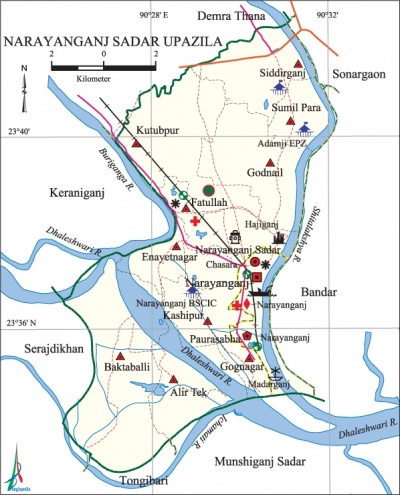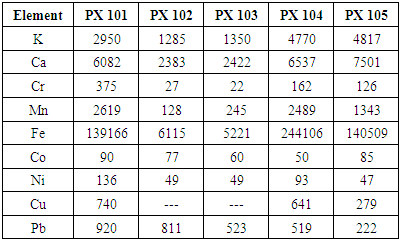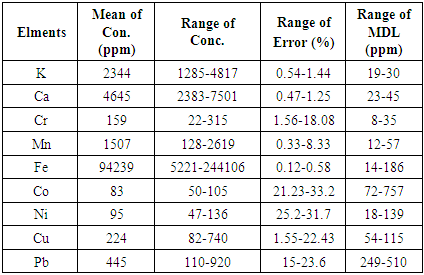-
Paper Information
- Paper Submission
-
Journal Information
- About This Journal
- Editorial Board
- Current Issue
- Archive
- Author Guidelines
- Contact Us
American Journal of Environmental Engineering
p-ISSN: 2166-4633 e-ISSN: 2166-465X
2019; 9(1): 8-11
doi:10.5923/j.ajee.20190901.02

Heavy Metals Content in Soil Sample Collected from Narayanganj Industrial Area, Bangladesh Using Proton Induced X-ray Emission
S. Akter1, R. Khatun1, M. M. Ahasan2, M. F. Uddin2, H. M. Jamil2, A. N. Monika2, M. A. Rahman2, M. Rahman3, R. P. Das2, R. A. Sharmin2
1Medical Physics Division, Atomic Energy Centre, Dhaka, Bangladesh
2Institute of Nuclear Medical Physics, AERE, Savar, Dhaka, Bangladesh
3Accelerator Facilities Division, Atomic Energy Centre, Dhaka, Bangladesh
Correspondence to: S. Akter, Medical Physics Division, Atomic Energy Centre, Dhaka, Bangladesh.
| Email: |  |
Copyright © 2019 The Author(s). Published by Scientific & Academic Publishing.
This work is licensed under the Creative Commons Attribution International License (CC BY).
http://creativecommons.org/licenses/by/4.0/

Soil samples were collected from two different steel industries of Narayanganj District, Bangladesh. The samples were then dried, made fine powder and the pellets have been made for irradiation by 2.2 MeV proton beams of current ranges from 10 to 15 nA. Ion Beam Analyzing (IBA) technique Proton Induced X-ray Emission (PIXE) was used for sample irradiation. Data acquisition has been done using MAESTRO-32 software and the data files are analyzed using GUPIX/DAN-32. Elements to be found in the studied samples are: K, Ca, Cr, Mn, Fe, Co, Ni, Cu and Pd. Heavy metal with higher concentration was found in the study area and the concentration of heavy metal decreases with depth. The main objective of the research work is to explore and identify heavy elements presence in soil samples affected by the industrial area for human health.
Keywords: Toxic elements, PIXE
Cite this paper: S. Akter, R. Khatun, M. M. Ahasan, M. F. Uddin, H. M. Jamil, A. N. Monika, M. A. Rahman, M. Rahman, R. P. Das, R. A. Sharmin, Heavy Metals Content in Soil Sample Collected from Narayanganj Industrial Area, Bangladesh Using Proton Induced X-ray Emission, American Journal of Environmental Engineering, Vol. 9 No. 1, 2019, pp. 8-11. doi: 10.5923/j.ajee.20190901.02.
Article Outline
1. Introduction
- Steel industry is an established and growing industry in Bangladesh. The industry has emerged as a major contributor to the national economy. According to the experts, the growth of steel industry in Bangladesh is mainly induced by the rapid expansion of the country's shipbuilding and real estate sector, as well as the major investments in various infrastructure projects throughout the country [1]. But the unplanned industrialization of a city area are continuously discharging their waste in the public places which pollute soil, water, air and thereby pollute crops and vegetables. A huge number of industries are built in and around Narayanganj district. Heavy metal from these industries or other sources carries significant amounts of toxic heavy metals such as Co, Ni, Cu, Zn and Pd which contaminates the soil as well as effect in environmental pollution. The aim of the research is to explore the effect of heavy metal pollutants for better survival of individual [2].
2. Methodology
2.1. The Study Area
- Soil samples listed in Table 1 were collected from two steel industries in Narayanganj District (Fig. 1). Narayanganj is the oldest District of Bangladesh. It is also a center of business and industry, especially the jute trade and processing plants, and the textile sector of the country. The area of current Narayanganj District is about 684.37 Sq Km. the weather is fairly moderate and the summer and winter are in the interval in the region. The average temperature of the district is 17.5° F. The amount of the annual average rainfall is 183 cm. The Geo position of the district is between 23°34’ to 24°15' North Latitude and between 90°27' to 90°59' East Longitude [3].
|
 | Figure 1. Narayanganj District, Bangladesh |
2.2. Sample Collection and Preparation
- Soil samples were collected at different locations (near chimney, at a distance of 20 and 60 ft from chimney surface (top soil) and lower (subsoil)) from two different steel industries of Narayanganj district. Each sample was properly leveled and kept on the drying oven (“Memmert Schutzart DIN 40050 – IP 20” at temperature of 60°C) for about two week in individual petri-dish. The samples were made dry in such a way that it contains no aqua which was obtained by recording the mass of the sample with a micro balance. The samples were grinded with an Agate Mortal Pester into fine powder. In order to avoid the cross contamination pester, pliers and other related equipment were also cleaned with acetone after grinding each sample. Then the samples of 0.7 mm were made by Hydraulic Pellet Maker.
2.3. Analysis of Samples
- The experiments were done with 2.2 MeV proton beam with beam current of 10 nA produced from the 3 MV Van de Graaff Accelerators at Atomic Energy Centre, Dhaka, Bangladesh Atomic Energy Commission [4]. In PIXE, the characteristic X-rays emitted from the sample were detected using a 30 mm2 Si(Li) detector (Model: SL30165) and associated electronic setup. The PIXE analysis provides high Z elements and gives the accurate concentration of the most of the elements present in the samples with high accuracy [5]. In the PIXE technique, MAESTRO software was used to collect the X-ray emission spectrum and for analyzing PIXE spectra, GUPIX with DAN32 interfacing software were used [6].
3. Results and Discussions
- The pollution of soil by heavy metal due to several types of industries has now become a global issue. Steel and iron industries are the most important source of soil pollution. The elements that were found in the studied samples are K, Ca, Cr, Mn, Fe, Co, Ni, Cu and Pd which are listed in Table 2 and Table 3 for Industry 1 and Industry 2 respectively. Table 4 shows the Comparison of Elemental constituents of soil (in ppm) with IAEA Soil-7.
|
|
|
|
|
 | Figure 2. Pie diagram of the mean concentration of elements (in ppm) |
4. Conclusions
- Higher metal concentration such as lead, iron, nickle, copper, cobalt was found in the study area and the concentration was higher than the background level. Metal concentration in the industrial area was higher than other area. It was observed that most of the heavy metal with high concentration was found from the top soil of the studied area and the concentration of heavy metal is decreases with depth. Constant monitoring of heavy metal pollution caused by different types of industries is needed to reduce such type soil as well as environmental pollution.
ACKNOWLEDGEMENTS
- The Authors are grateful to the Management and Staff of Accelerator Facilities Division of Atomic Energy Centre, Dhaka for giving technical support in this work.
 Abstract
Abstract Reference
Reference Full-Text PDF
Full-Text PDF Full-text HTML
Full-text HTML




